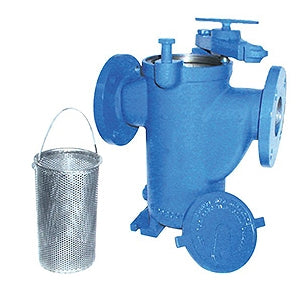A basket strainer is a device that uses a mesh screen to filter out foreign particles in a horizontal pipeline. These particles are then removed from the strainer and will not make their way into downstream equipment like pumps, valves, and traps. Read the following to learn more about basket strainers, how they work, and how to choose the best strainer for your application.
How Basket Strainers Work
Basket strainers are installed to protect equipment from damage caused by unwanted debris that may be in the pipeline. The unwanted debris could be dirt or other foreign particles that make their way into the process fluid. Typically, basket strainers are installed in horizontal pipelines and in situations where high flow capacity is required.
These strainers are installed upstream of equipment like pumps, control valves, and traps, keeping potentially corrosive or damaging debris from making its way down the line. They can be installed alone or in a series to increase filtration. They may come with a single chamber (simplex strainers) or multiple chambers (multiplex strainers). To read more about the differences between simplex and duplex strainers, check out this post.
Understanding Mesh Sizing
Each strainer is designed with a mesh lined basket to filter and collect the unwanted debris. Mesh size should be chosen based on the job function, not the size of the system. Selecting a mesh with openings that are too small could result in more frequent clogged lines, while a mesh with significantly larger openings could permit more unwanted debris to flow through the pipeline and equipment. Ideally, then, you’ll want to choose a mesh where the perforation is slightly smaller than the smallest particle you’ll need to filter out.
Mesh size is measured by the number of openings in one linear inch of screen. For instance, a 16-mesh screen would have 16 openings per inch, while a 100-mesh screen would have 100 openings. Higher numbers, therefore, are able to strain out smaller particles with a finer weave. The baskets are typically made of stainless steel for quality and durability.
Factors for Selecting the Right Basket Strainer
Each application could require a different basket strainer. Consider the unique functions of your pipeline before deciding on a strainer. Important factors include the pressure and temperature requirements of your line, the type of liquid flow (corrosive, abrasive, etc.), debris size, and the frequency of cleaning and maintenance. You may also consider a duplex style basket strainer (such as these), which holds two strainer baskets fed by diverting valves. This system allows one basket to be cleaned and serviced while the other maintains flow.
How to Maintain Basket Strainers

Unlike filters that must be replaced periodically, basket strainers can be used continually, as long as they are cleaned and maintained properly. In high flow systems, maintaining pressure is key to a functioning pipeline. Installing pressure gauges on either side of the basket strainer can alert you to potential clogs in the line. Pressure building up in the strainer will indicate that the strainer needs to be removed and cleaned. Failing to maintain the strainer could cause a serious clog, requiring replacement of the strainer, so be sure to monitor the pressure closely.
Regardless of pressure readings, regular cleanings are recommended to ensure the longevity of the strainer. It’s important to note that before you remove and clean a basket strainer, you must depressurize the line, as servicing a pressurized strainer could result in personal injury or damage to the equipment. Once removed, flush the strainer and soak in a cleaning solution. Scrub with a brush as needed, and avoid letting debris harden on the mesh. To avoid complete system shutdowns, you may want to have extra screens on hand to use during the cleaning process.
View our selection of Eaton Replacement Basket Strainers here and our selection of Titan Replacement Basket Screens here.
Advantage to Using Basket Strainers
Installing a basket strainer into a pipeline system ensures that equipment downstream is protected from unwanted and potentially damaging debris. Choose a mesh size slightly smaller than the particles you wish to filter, to ensure that any foreign particles are trapped in the basket. You’ll also want to consider other factors, like the temperature and pressure requirements, and the type of liquid or gas passing through the basket strainer. Be sure to maintain your basket strainer by checking pressure periodically and scheduling regular cleanings as well. This small investment will have lasting impact on downstream equipment.

